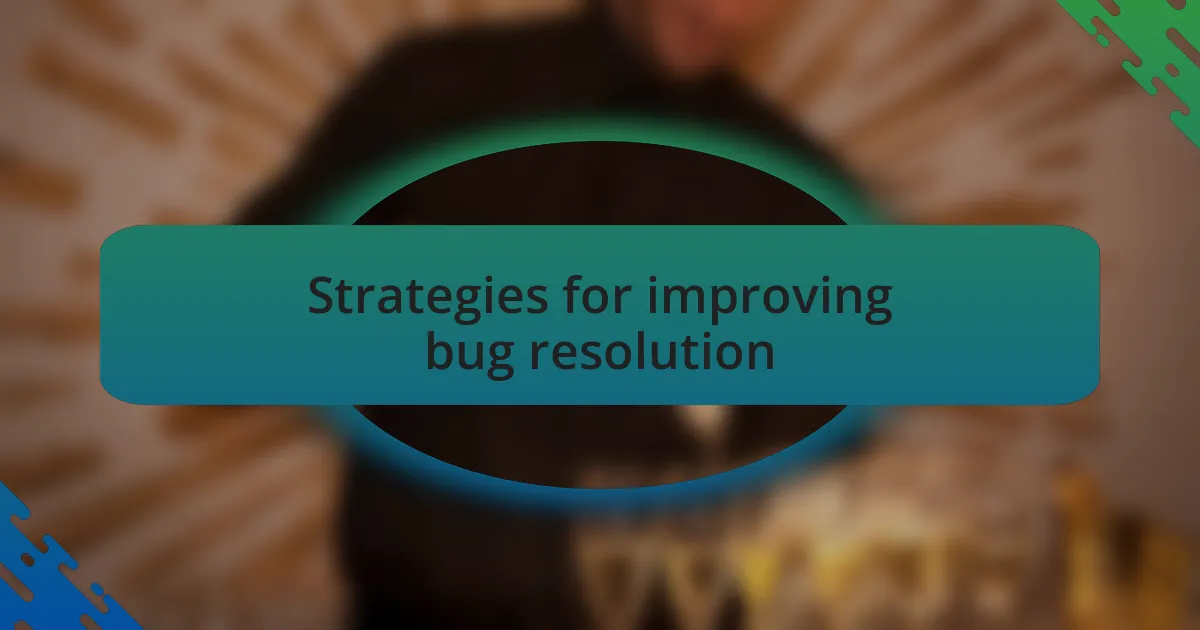Key takeaways:
- Establishing a clear protocol for logging and categorizing bugs enhances team productivity and fosters collaboration.
- Utilizing user-friendly tools like JIRA, Bugzilla, and GitHub’s issue tracker simplifies the bug tracking process and improves efficiency.
- Maintaining a standardized issue report format and promoting prompt updates lead to better communication and quicker resolutions.
- Involving the entire development team in the bug resolution process encourages collaboration and leverages diverse insights for effective problem-solving.
![]()
Understanding bug tracking processes
Understanding bug tracking processes is essential for any software development team aiming for success. I remember the first time I delved into a bug tracking tool; it felt like opening a treasure chest of information. Each bug was a chance to improve the product and deepen my understanding of its functionality.
The process begins with the identification of a bug, but what happens next often defines the effectiveness of your tracking system. I found it enlightening to create a clear protocol for logging issues. This simple act transformed our team’s approach to problem-solving, making it feel less like fire-fighting and more like a collaborative effort toward improvement. Have you ever experienced that moment when a well-documented bug leads to a significant breakthrough?
Moreover, prioritizing and categorizing bugs is another crucial aspect that can enhance productivity. Initially, I underestimated the power of this step until I saw how prioritization helped my team focus on issues that mattered most. It made me wonder, how can we ensure that we’re always tackling the biggest impact first? Reflecting on my past experiences with bug tracking processes, I realized that effective communication within the team is the backbone of addressing bugs efficiently.
![]()
Common tools for bug tracking
When it comes to bug tracking, I’ve found a few tools that truly stand out. For instance, JIRA is a popular choice among many development teams because of its robust features and customizable workflows. I still remember the first time I used JIRA; it was enlightening to see how it integrated with our agile process, allowing us to track issues seamlessly through different stages of development.
Another tool worth mentioning is Bugzilla. I recall a project where Bugzilla saved us a lot of headaches by providing all the essential features in a straightforward interface. Its ability to manage complex bugs while still being user-friendly stood out to me. Have you ever faced a situation where a complicated tool actually made things worse? Having a tool that is easy to navigate can really enhance your team’s efficiency.
Finally, I can’t overlook GitHub’s issue tracker, which many developers swear by for its simplicity and direct integration with code repositories. It was a game-changer for our team when we transitioned to GitHub because we could link bugs directly to the codebase. It made me ponder how essential it is for tools to foster a connection between coding and tracking; after all, isn’t that where the real magic happens?
![]()
Best practices for effective tracking
Effective bug tracking hinges on clarity and communication. From my experience, I’ve found that maintaining a well-defined issue report format can significantly reduce confusion. I remember a project where team members misinterpreted vague descriptions, leading to delays. Have you ever spent hours troubleshooting a bug, only to discover that the report wasn’t clear? Standardizing fields like Priority, Severity, and Steps to Reproduce can help everyone get on the same page quickly.
Another best practice I’ve come to appreciate is fostering a culture of prompt updates and feedback. In one of my earlier teams, we established a routine where anyone working on a bug would leave a comment immediately after making any progress. It created a sense of accountability and kept the momentum going. I often wonder how much smoother projects could flow if everyone committed to being more transparent—don’t you think?
Moreover, leveraging analytics within your tracking tool can provide invaluable insights. In a previous role, we used reports generated by our bug tracker to identify recurring issues, which helped us address root causes rather than merely symptoms. That sense of discovery was exciting! How many times have you faced the same bug, only to find it re-emerge weeks later? By analyzing these patterns, your team can evolve and prevent future headaches, ensuring continual improvement in your software’s quality.

Strategies for improving bug resolution
One effective strategy for improving bug resolution is to implement regular review meetings to assess unresolved issues. In a prior project, we held weekly sessions where team members could openly discuss challenges they faced and brainstorm potential solutions together. It was a revelation! I noticed that simply by discussing bugs in a collaborative environment, we often discovered fixes faster and shared insights that one person might not have considered alone. Have you ever wanted to resolve a bug, only to get stuck? Sometimes, talking it out with others can unlock new perspectives.
Another approach I’ve found to be beneficial is to prioritize issues based on user impact rather than just technical complexity. I recall a situation where our team was bogged down by a complex bug that affected only a handful of users while neglecting a simpler but widespread issue that frustrated many. Shifting our focus to what truly mattered to users not only enhanced our product but also increased our team’s morale as we felt we were making a real difference. Isn’t it rewarding to fix the things that actually enhance user experience?
Additionally, I suggest involving the entire development team in the bug resolution process. In one memorable experience, we initiated cross-functional workshops where developers, testers, and product managers worked side by side to resolve bugs. This collective effort not only increased our understanding of the software but also fostered a stronger team dynamic. Have you ever felt the thrill of working together to solve a problem? It’s an exhilarating experience that reinforces the idea that bug resolution is a shared responsibility, not just a task for the QA team.